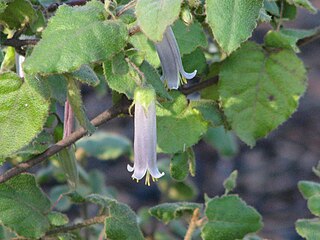
Olearia teretifolia, commonly known as cypress daisy-bush, is a species of flowering plant in the family Asteraceae and is endemic to south-eastern continental Australia. It is a slender, erect to spreading shrub with more or less sessile, linear leaves pressed against the stem, and white and yellow, daisy-like inflorescences.

Grevillea erectiloba is a species of flowering plant in the family Proteaceae and is endemic to inland areas of south-west of Western Australia. It is dense, rounded shrub with divided leaves with up to fifteen linear lobes, and groups of bright red flowers that are green in the bud stage.

Correa aemula, commonly known as the hairy correa, is a species of shrub that is endemic to south-eastern Australia. It has broadly heart-shaped leaves arranged in opposite pairs, green or greyish green, pendent flowers arranged singly or in pairs and ageing to mauve-purple.

Elaeocarpus holopetalus, commonly known as black olive berry, mountain blueberry, or mountain quandong, is species of flowering plant in the family Elaeocarpaceae and is endemic to eastern Australia. It is a shrub or small tree with regularly toothed, lance-shaped to egg-shaped leaves, racemes of white flowers and black, oval fruit.

Goodenia macmillanii, commonly known as pinnate goodenia, is a species of flowering plant in the family Goodeniaceae and is endemic to Victoria, Australia. It is an erect, short-lived perennial shrub with lyrate or lobed leaves, egg-shaped to elliptic in outline with toothed edges, and leafy racemes of bluish-purple flowers.

Darwinia micropetala, commonly known as small darwinia, is a species of flowering plant in the family Myrtaceae and is endemic to south-eastern continental Australia. It is a small, erect shrub with linear leaves, and heads of white to pink flowers.

Prostanthera walteri, commonly known as blotchy mint-bush, is a species of flowering plant that is endemic to south-eastern Australia. It is a sprawling shrub with tangled, hairy branches, egg-shaped leaves and usually bluish green flowers with prominent purple veins arranged singly in leaf axils.
Melicope contermina is a species of shrub or small tree in the family Rutaceae and is endemic to Lord Howe Island. It has trifoliate leaves and white flowers borne in leaf axils in panicles of nine to fifteen flowers.

Prostanthera decussata, commonly known as dense mintbush, species of flowering plant that is endemic south-eastern Australia. It is a dense, compact, strongly aromatic shrub with egg-shaped leaves and mauve to violet flowers with yellow streaks, arranged in leaf axils near the ends of branchlets.

Persoonia brevifolia is a plant in the family Proteaceae and is endemic to a restricted area near the border between south-eastern New South Wales and Victoria. It is an erect shrub with elliptic to egg-shaped leaves and cylindrical yellow flowers arranged singly in leaf axils.

Persoonia acicularis is a species of flowering plant in the family Proteaceae and is endemic to the west coast of Western Australia. It is a shrub with linear, sharply-pointed leaves and yellow flowers in groups of up to eighty.
Persoonia brachystylis is a species of flowering plant in the family Proteaceae and is endemic to a restricted area on the west coast of Western Australia. It is an erect, spreading shrub with smooth bark, narrow spatula-shaped to lance-shaped leaves and yellow flowers in groups of ten to twenty.

Grevillea eriobotrya, commonly called the woolly cluster grevillea, is a species of flowering plant in the family Proteaceae and is endemic to a small area in the south-west of Western Australia. It is dense, erect, spreading shrub usually with linear leaves, and groups of white to creamy-white flowers.

Grevillea pityophylla is a species of flowering plant in the family Proteaceae and is endemic to inland areas of Western Australia. It is a dense shrub with linear to more or less cylindrical leaves and hairy, pinkish-red to bright red flowers.

Isopogon crithmifolius is a species of plant in the family Proteaceae and is endemic to the south-west of Western Australia. It is a shrub with divided leaves and more or less spherical heads of glabrous reddish pink flowers.

Kennedia lateritia, commonly known as Augusta kennedia, is a species of flowering plant in the family Fabaceae and is endemic to the south-west of Western Australia. It is a woody climber with twining stems, trifoliate leaves and orange-red and yellow flowers arranged in groups of up to twenty-four.

Boronia filifolia, commonly known as the slender boronia, is a plant in the citrus family Rutaceae and is endemic to south-eastern Australia. It is a slender shrub with simple or pinnate leaves and pale to deep pink four-petalled flowers.

Melicope vitiflora, commonly known as northern evodia, fishpoison wood, leatherjacket or leatherwood, is a species of shrub or small tree in the family Rutaceae and is native to north-eastern Australia and New Guinea. It has trifoliate leaves and green to white or cream-coloured flowers borne in panicles in leaf axils.
Petrophile multisecta, commonly known as Kangaroo Island conesticks, is a species of flowering plant in the family Proteaceae and is endemic to Kangaroo Island in South Australia. It is a prickly shrub with rigid, much-divided leaves with sharply pointed tips, oval to spherical heads of hairy cream-coloured flowers and oval fruit.
Goodenia stenophylla is a species of flowering plant in the family Goodeniaceae and is endemic to the south-west coast of Western Australia. It is an erect shrub with linear or tapering leaves and racemes of white flowers with purplish spots.

















